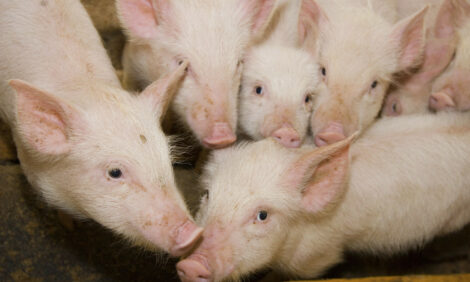



Genome of Commercial Pig Reveals Asian Blood
NETHERLANDS - In a new paper on the sequencing of the pig genome from Wageningen University, it emerges that the pig's genome is not only useful in terms of pig breeding; its similarities with humans also make it important for biomedical research.An examination of the almost three billion base pairs that make up the genome of the pig has revealed Asian blood flowing through the veins of pigs in European pigsties. The publication in Nature, along with twenty simultaneous publications in various other scientific journals, presents the findings of a survey set up to examine the swine genome. The genome has been analysed by the international Swine Genome Sequencing Consortium, which operated in 12 countries and was headed by researcher Professor Martien Groenen from Wageningen University, part of Wageningen UR, and two researchers from Great Britain and America. The swine genome is not only useful in terms of pig breeding; the similarities with humans also make it important to biomedical research.
The research team of 136 authors in 54 research groups, led by Alan Archibald from Edinburgh University, Larry Schook from the American University of Illinois and Martien Groenen from the Animal Breeding and Genetics Group at Wageningen University, has sequenced the entire genome of the pig. The total size of the swine genome is 2.8 billion base pairs, containing 21,640 protein-coding genes. This is similar to that of other mammals, including humans. The pig has 19 pairs of chromosomes. The variation in the genome, even within the most commercial breeds of pigs, is two to three times higher than in humans. Pigs have a highly developed sense of smell and the largest number of active genes for recognising smells ('olfactory receptors') of all animals that have undergone genomic sequencing up until now. On the other hand, pigs have fewer taste genes, enabling them to eat food that humans would reject, such as waste and scraps.
The new genetic information will give scientists a better understanding of the various traits important in breeding. Livestock breeders will be able to make more informed decisions when breeding pigs. It is particularly useful in terms of traits that are difficult to identify in the daily practice, such as traits relating to swine health and the quality and flavour of the pork.
A start was made on mapping the swine genome twenty years ago, but recent technological advances have accelerated the process considerably.
Professor Groenen explained: "When the project started, nobody could have imagined that one day, we would be able to identify all three billion base pairs on the swine genome. And certainly not for several animals."
His comment refers to the fact that the researchers did not limit their studies to just one animal, but also sequenced the genomes of dozens of pigs of different breeds, as well as of ten wild boar from Europe and Asia. Their research showed that the European and Asian wild boar species went their separate ways around a million years ago. It also confirmed that European and Asian pigs were domesticated completely independently of each other. Asian domesticated pigs were used to improve the European breeds being farmed in the 18th and 19th centuries, a process recorded in 1868 by Darwin in his book 'The Variation of Animals and Plants under Domestication'. Based on this latest sequencing of the swine genome, the researchers estimate some 35 per cent of the genome of today's commercially bred pigs can be traced back to these original Asian breeds.
But Professor Groenen sees this as just the beginning of a highly detailed map of the entire swine genome, in which hundreds, if not thousands, of animals can play a part.
He said: "This information will be invaluable not only to the pig breeding sector, but also in terms of using pigs for biomedical and fundamental biological research."
When mapping the genome of various animals, researchers found a number of variants of genes that may be linked to an increased risk of certain diseases in humans, such as obesity, diabetes, Alzheimer's and Parkinson's disease. They can now go on to study the effect of these variants in animals that are physiologically similar to humans. Like humans, pigs are omnivorous and their digestion and physiology are very similar to that of humans. In addition, the size of their internal organs, including the heart, kidneys and pancreas, largely corresponds with the size of human organs. This makes the pig an important model for medical research.
Man and pig share a history that goes back 10,000 years when, unbeknownst to each other, people in Europe and Asia started to domesticate pigs. Pigs have been an important source of animal protein ever since. Production and consumption amounts to a hundred billion kilos per year, and makes pork the most widely eaten meat in the world today.
Publication
Martien A.M., Groenen et al., Analyses of pig genomes provide insight into porcine demography and evolution, Nature, 491:393-398, 15 November 2012.








